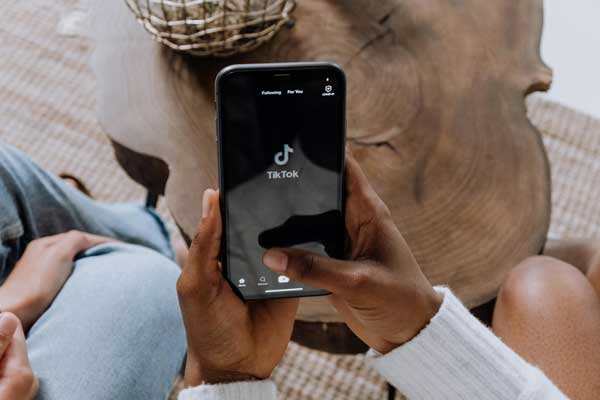TikTok’s rise as a news source blurs the line between fact and opinion

[TikTok. Photo Credit to Pexels]
44% of US Gen Z users now say they are using TikTok for news, up from just 15% three years ago, the Reuters Institute Digital News Report 2024 found.
As TikTok transforms from a platform for dance trends into a dominant news source for Gen Z, concerns are mounting about whether today’s youth can tell the difference between fact and fiction in an era where likes matter more than truth.
In contrast to professional reporters and editorial filtering in mainstream newspapers or broadcast television news, TikTok delivers information through rapid-fire algorithmic feeds by anyone who owns a smartphone and has access to the platform.
The platform’s “For You” page recommends content based not on truth or trustworthiness, but on audience engagement, which favors sensationalist, dramatic, or simplified content over fact-based nuance.
This enables misinformation, disinformation, and rumors to travel far and wide before fact-checking or correction can occur.
BBC investigators uncovered that during the initial phases of the 2023 war between Gaza and Israel, false videos and bogus clips of unrelated events went viral on TikTok, deceiving millions of people and promoting harmful narratives.
The speed at which misinformation spreads on TikTok is especially concerning since Gen Z users are mostly consuming such information in isolation, without cross-checking it with credible sources.
Most viewers regard a video with hundreds of thousands of likes or shares as credible even if it has been produced by an uncredentialed creator with no supporting evidence or journalistic credentials.
A study conducted by Stanford University found that over 80% of middle school students mistook sponsored content for real news and many high school students failed to identify verified accounts, revealing serious weaknesses in media literacy despite growing reliance on platforms like TikTok for information.
TikTok’s format encourages creators to sacrifice context and nuance for popularity and views.
As a result, difficult political or scientific subjects are routinely boiled down into brief sound bites or provocative images, leaving the audience with a superficial or misleading understanding of important matters.
Many creators oversimplify global conflicts, medical advice, or financial advice into 15-second videos that may be pleasing to viewers but are not necessarily accurate.
Sometimes misinformation occurs by error, but often creators deliberately spread false information to gain followers, generate outrage, or advance a particular agenda.
For instance, some present themselves as political correspondents or analysts but lack the proper training that is required, and others blur the line between satire and factual reportage so closely that it becomes difficult for viewers to know what to believe.
Adding fuel to the fire is TikTok’s algorithm that amplifies content that elicits strong emotions such as outrage and indignation, the same reactions most often elicited by sensationalized reporting.
The larger question that society is grappling with isn't whether Gen Z will continue to consume TikTok as a news source — they will — but whether it is possible to educate them on how to do so responsibly.
As social media platforms become gatekeepers of how information is shared and conveyed, the line between being informed and being influenced is becoming increasingly blurred.
Currently, TikTok is a double-edged sword: both a place of empowerment and learning, but also of uncertainty and danger, a reflection of the digital world that Gen Z inherits.
Although TikTok is becoming the go-to source for news among Gen Z, the phenomenon has caused global concern as young users struggle increasingly to distinguish accurate information from false information.
Furthermore, in the University of Virginia’s 2024 media literacy research, just 11% of 18- to 29- year olds scored well on a test designed to identify fake news, whereas 36% received low scores, indicating that younger generations are more susceptible than older generations when it comes to identifying AI-created misinformation.
TikTok’s algorithm, which prioritizes emotional responses over factual accuracy, means that politically charged posts and health misinformation garner the most engagement, especially when content creators make exaggerated statements.
During the COVID-19 pandemic and more recently in finance, TikTok was flooded with misleading videos by unqualified influencers promoting dubious health advice and risky investment schemes to millions.
Experts at Stanford and the American Press Institute recommend that media literacy be taught in middle school so students can critically evaluate sources, check facts, and identify bias.
TikTok has partnered with fact-checkers and added warning labels to manipulative videos, but these efforts may be too little, too late, to battle viral misinformation.
Addressing this challenge is the responsibility of educators, technology companies, and users, especially young ones, who must learn to consume information critically.
As TikTok’s role in disseminating news grows, it becomes increasingly important to ensure Gen Z consumers evaluate information carefully in order to maintain global awareness and democratic institutions.

- Ray An / Grade 9
- Asia Pacific International School

![THE HERALD STUDENT REPORTERS [US]](/assets/images/logo_student_us.png)
![THE HERALD STUDENT REPORTERS [Canada]](/assets/images/logo_student_ca.png)
